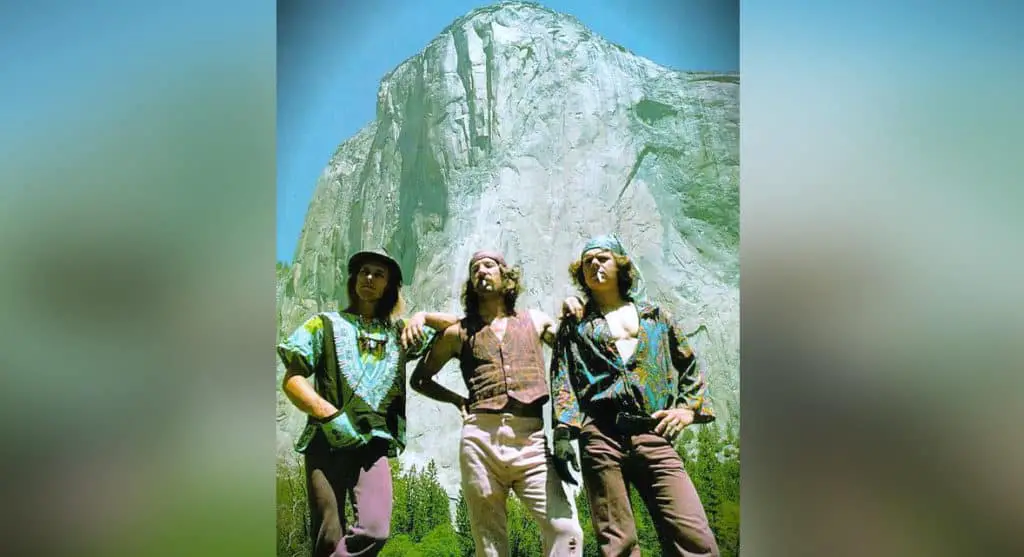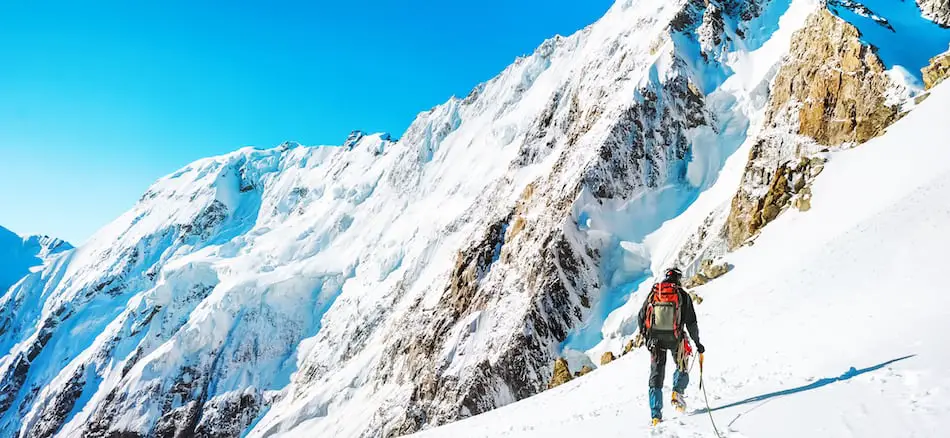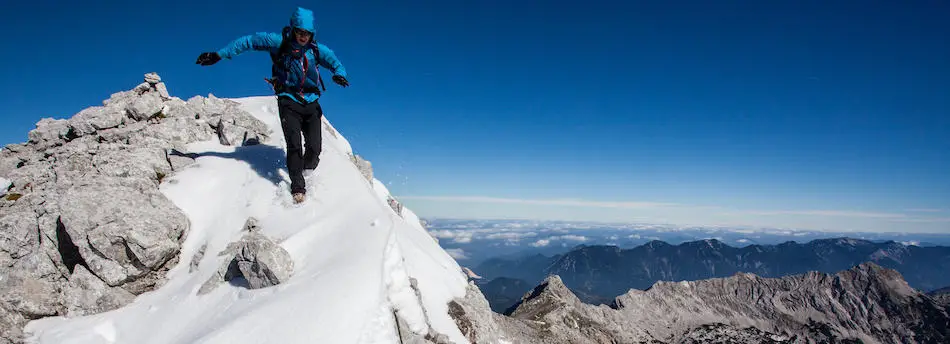
Rock climbing and mountaineering have a lot of similarities on the surface, but they are actually very different sports. I’ve written the following guide to show the comparison between the two!
So, what’s the difference between mountaineering and rock climbing? Rock climbing is a specific activity centered around vertical cliffs, while mountaineering is a more holistic sport focused on summiting mountains.
Essentially, rock climbing is a more specific sport than mountaineering. Mountaineering is broadly defined as the act of summiting hard-to-reach peaks using a variety of skills like rock climbing, ice climbing, or skiing. Rock climbing, however, centers only around using your hands and toes to climb sheer vertical faces, where the summit may not be the eventual goal.
Mountaineering vs Rock Climbing

First, I think it’s best to define each word:
- Rock climbing is the sport of scaling vertical or near-vertical cliffs using your hands and feet. Sometimes you want to get to the top of the cliffs; other times, you only need to reach a set of ‘anchors’ that signify the end of the ‘route’ that you’re on. The goal isn’t always the top; it’s to climb an established line of holds that someone else has already climbed.
- Mountaineering is the technical form of mountain climbing, where you try to get to the top of hard-to-summit mountains using a variety of skills. It often involves hiking up steep terrain, dealing with snow and ice, and crossing large glaciers.
In essence, mountaineering is a much more broad sport than rock climbing is.
To better understand this difference between the two sports, a good analogy can be made using track and field: rock climbing is like running a 5000-meter race, while mountaineering is like running a triathlon or a decathlon.
By this I mean that rock climbing is its own specific activity, whereas mountaineering is much more comprised of other activities. When you’re rock climbing, you only rock climb; when mountaineering, though, you’ll need to use a variety of different skills to get to the summit of whatever peak you’re aiming for.
These skills could include glacier travel, hiking, mixed climbing, and others. In fact, one of the skills required for mountaineering is rock climbing, which is why you’ll often see a high overlap between people who rock climb and people who mountaineer.
Now, the line between the two disciplines can get fuzzy at some points. For example, in the film Meru, three alpinists (Jimmy Chin, Conrad Anker, and Renan Ozturk) attempt to climb a ridge in the Himalayas. For much of the ridge, they’re on a sheer rock face, using rock climbing tools and equipment.
So, are they rock climbing, or are they mountaineering? The answer is that they’re actually doing both! This is one of the interesting things about this distinction: you can be rock climbing as part of a mountaineering trip, because rock climbing is one of the elements that goes into mountaineering.
However, you can also rock climb without mountaineering. When you go to a climbing gym, or even if you just go to the local crag, you aren’t really considered to be mountaineering. In fact, I would say that the vast majority of people who rock climb are not mountaineering.
So, where does the distinction lie? How do you know which activity you’re doing? The answer to this question can be found in the historical context between the two.
Historical Context

As a sport, mountaineering preceded rock climbing by more than a hundred years. In fact, the roots of mountaineering can be traced back as far as the 1786, when Michael Gabriel Paccard and Jacques Balmat summited Mont Blanc.
This introduced the world to the art of high-elevation mountaineering, and the sport exploded; over the next 150 years, mountaineering spread throughout the world, from the Alps to the Andes to the Himalayas, reaching its peak in 1953 when Mount Everest was first summited.
In these early days, rock climbing didn’t exist as a stand-alone sport. It was simply seen as an extension of mountaineering, more a means to an end than anything else; mountaineers would rock climb when they needed to, but no one went out of their way to do it. The only time is was practiced was when it was necessary to reach the summit of a mountain.
This began to change in the 1950’s. To understand how rock climbing came to grow, it’s important to understand what the world was like that time, especially in America. World War II had just ended, and a sense of security had settled over the nation: people wanted conformity, risk avoidance, and a factory job that could buy them a house and a dishwasher.
Mountaineering fit in well with the cultural philosophy at the time. It was seen as a proper sport practiced by gentlemen, who took every step possible to minimize the danger that they were in.
After a little while, though, a counterculture began to form. Led by novelists such as Jack Kerouac, American youth began to seek out challenges and fight back against the conformist nature of their society. They discovered mountaineering, but pushed back against its strict rules and risk-averse attitude.
As a way to rebel against much of the pomp surrounding mountaineering, they took rock climbing — which was little more than a fringe activity — and turned it into its own sport.
Instead of climbing only when necessary and taking the easiest possible route to the top, these rebellious youth started to seek out challenging cliff faces, pushing themselves to their physical limit to see if they could be climbed. Thus, the sport of rock climbing was born.
I think this story highlights one of the main differences between rock climbing as part of a mountaineering trip, or rock climbing as its own activity: if you’re rock climbing as part of a mountaineering trip, you’ll often look for the easiest way to the top. If you’re climbing just to climb, you might well look for the hardest route to the top, just to challenge yourself.
Similarities and Differences

Now that we’ve gone over what rock climbing and mountaineering are, I thought it would be good to take a little bit about the ways in which the sports are the same, and the ways in which they might differ.
Similarities
Some of the main similarities between rock climbing and mountaineering include:
Environment
Both rock climbing and mountaineering often occur in mountainous environments, usually away from civilization. This is one of the main draws of the sports; being able to get out in nature while also practicing a challenging but rewarding activity can be great for your mental health.
Tools
Rock climbing and mountaineering use a lot of similar tools (although mountaineering has a much broader toolset). Much of the packs and clothing are similar, as well as the ropes and the protection used. Furthermore, a lot of the techniques (like belaying) are the same.
Differences
With that being said, there are also some key differences in the sport:
Variety of Skills/Tools Required
Like I mentioned above, mountaineering requires a much wider set of tools and skills to perform. On top of the rock-climbing gear (like harnesses and ropes), you will also need:
- An ice axe
- Mountaineering boots
- Avalanche gear
- Warm clothing
- Crampons
Similarly, you also need a wider variety of skills for mountaineering. As well as being a good rock climber, you should also be skilled in:
- Ice climbing
- Glacier travel and crevasse rescue
- Scrambling
- Skiing
- Snow travel
Danger
I’m just going to say it: mountaineering is a much more dangerous sport than ice climbing is. This is because it’s often practiced in more remote locations, with higher stakes and worse protection. You need to worry about avalanches, crevasses, hypothermia, and altitude sickness.
With rock climbing, you usually only have to worry about the danger of a fall. While this is still important, and it should still be taken seriously, it’s not as dangerous as mountaineering is.
Which Should I Do?

So, now that you know the differences between the two sport, I think it’s common to ask the question: which is best for you?
This really depends on your own personal preferences and what you’re trying to get out of the sport. Everyone has a different opinion and different experiences that can lead them to prefer one over the other; with that being said, I have a few pointers that might help you decide:
- Rock climbing is often more accessible. Even towns in the middle of the prairie will have a climbing gym that you can go to, allowing you to access the sport year-round. To go mountaineering, you need mountains, which not everyone has!
- Rock climbing is cheaper and easier to learn. One of the great things about rock climbing is that you could go tomorrow! All it takes is a climbing gym and a day pass (which is about $20). Mountaineering is much harder to get into, both because of what we talked about above and because of how many skills you need to know. You’ll probably have to hire a guide to go mountaineering, and that can cost upwards of $200.
- Mountaineering is more rewarding. Now, this is a HIGHLY controversial subject, and I have to preface it by saying that this is only my opinon. I’m an avid rock climber and I love it dearly, but if I had to choose, I would say that I do find mountaineering more rewarding. The combination of the danger, remoteness, and high skill levels required all come together to make it a truly amazing sport to pursue.
